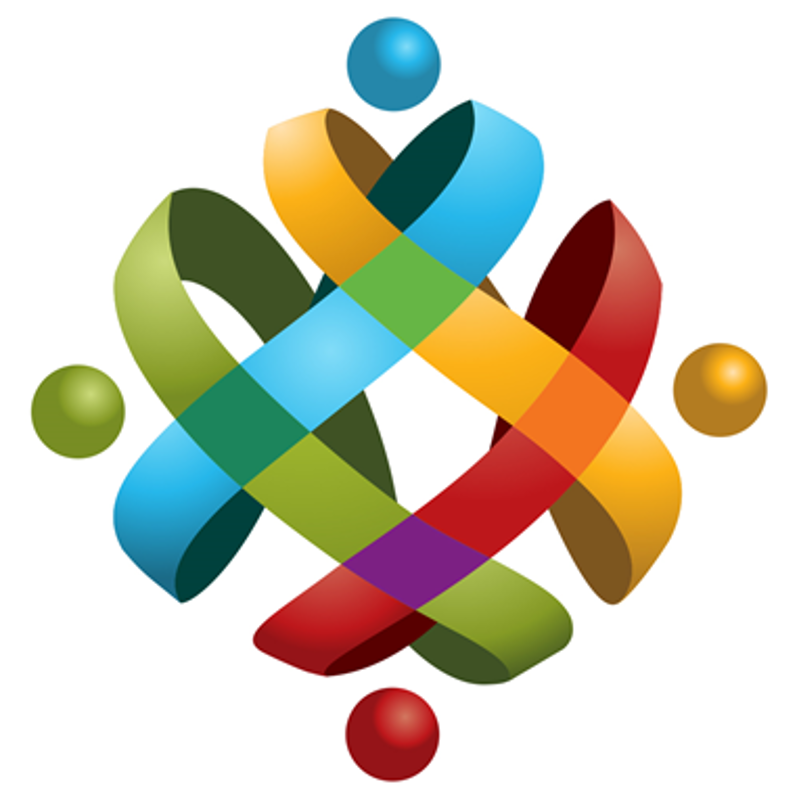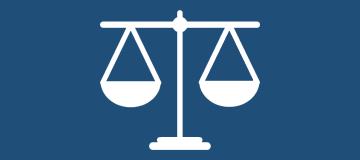Gender Results Framework
Statistics Canada has compiled data on each of the indicators of the Gender Results Framework as well as other key indicators related to gender.
Dashboards are available below for Education and skills development, Economic participation and prosperity, Leadership and democratic participation, Gender-based violence and access to justice, Poverty reduction, health and well-being and other Statistics Canada gender indicators, allowing users to view and interact with relevant data.
Explore the data
Gender, Diversity and Inclusion Statistics Catalogue
The GDIS catalogue is a database that enables you to find data tables, publications, and data visualizations, but with a focus on disaggregated data and analytical products on gender, diversity and inclusion. You can filter the catalogue easily by population group or by searching using a keyword. For a wider variety of information and subjects check out the Statistics Canada Data page.
You can initiate a search from this page by using the search features below which will take you to the catalogue page with the results of your query pre-populated. You have two options for searching from this page; you can search by typing a keyword in the search bar and hitting the Enter key, or you can select one of the 7 links below the search bar (6 options for "population group" and 1 "Browse all" option). Once you are taken to the catalogue page, your search term will be displayed in the search bar under the "Phrase or keyword" heading, or the population group you chose will be checked in the dropdown for "Population groups". The search will notify you how many results are found and the number of pages. There are additional filters under the dropdowns "Identity factors and other" and "Type" that you can select to narrow your search. You can also sort the results chronologically or alphabetically by using the "Sort by" dropdown. You can use the "Results per page" drop-down to select how many results you would like presented before needing to skip to another page.

Search the GDIS catalogue
Browse by population group
What's new

The Disaggregated Data Action Plan's 2024-2025 Accomplishments Report, From Commitment to Continuity, is now available!
Since 2021, the Disaggregated Data Action Plan (DDAP) enhances the collection, analysis, and dissemination of disaggregated data to better reflect the diverse lived experiences of Canadians.
Below is a selection of recent releases that provide disaggregated insights across various population groups, demonstrating the value of detailed data for understanding Canada's population.
- Portrait of the South Asian Populations in Canada: Diversity and Socioeconomic Outcomes
- The median entry wage of new immigrants decreased by 10.6% in 2023 but remained above its pre-COVID-19 pandemic level
Additional recent releases
- The diverse volunteering contributions of racialized Canadians
- International Day of Persons with Disabilities, 2025: Highlighting the experiences of persons with disabilities
- An overview of the immigrant population born in the United States living in Canada
- 2024 Canadian Veteran Health Survey: Findings on the service to civilian transition
- Portrait of the Arab Populations in Canada: Diversity and Socioeconomic Outcomes
- Socioeconomic outcomes of transgender and non-binary people in Canada
- How long do Canadians with and without disabilities stay with their employer? A novel analysis by disability type
- Labour market outcomes of the Black populations in Canada, 2020 to 2025
- Proud to be Canadian: Pride and sense of belonging in 2025
- Renters' shelter costs by duration of tenancy
- Characteristics of cost-related avoidance of oral health services among people in Canada eligible for the Canadian Dental Care Plan
- Socioeconomic characteristics of workers in industries dependent on United States demand for Canadian exports
- Time pressure and time spent with friends over the last 30 years
- Life expectancy at birth and infant mortality rates of Indigenous populations in Canada
- Unfair treatment, racism and discrimination in community sports in Canada
For more information:
Recent releases
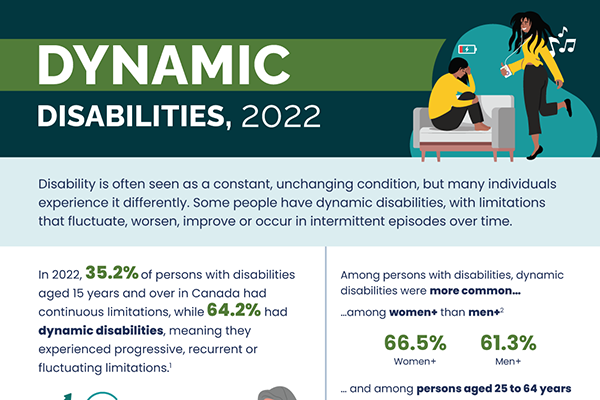
Infographic: Dynamic disabilities, 2022
Release date:
December 3, 2025
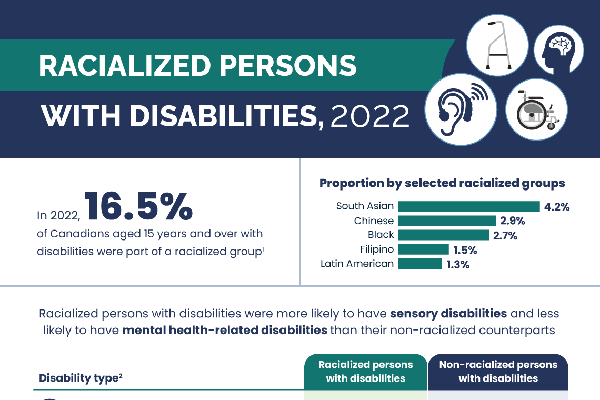
Infographic: Racialized persons with disabilities, 2022
Release date:
December 3, 2025
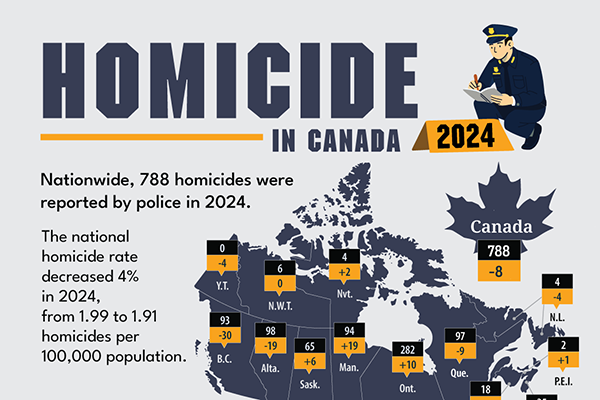
Infographic: Homicide in Canada, 2024
Release date:
December 2, 2025

An overview of the immigrant population born in the United States living in Canada
Release date:
November 13, 2025
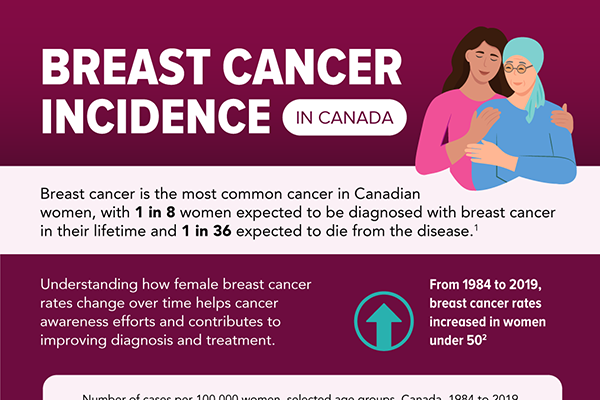
Infographic: Breast cancer incidence in Canada
Release date:
October 29, 2025
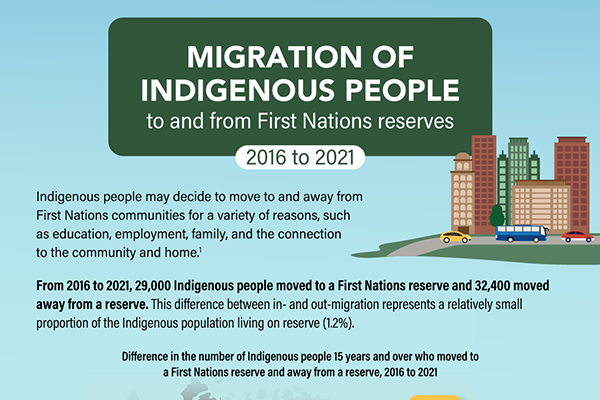
Infographic: Migration of Indigenous people to and from First Nations reserves, 2016 to 2021
Release date:
October 29, 2025
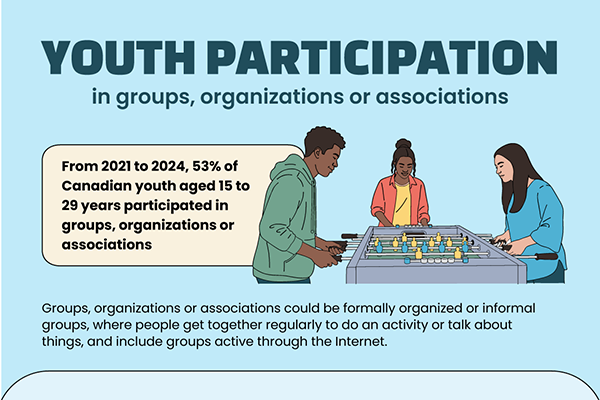
Infographic: Youth participation in groups, organizations or associations
Release date:
October 29, 2025
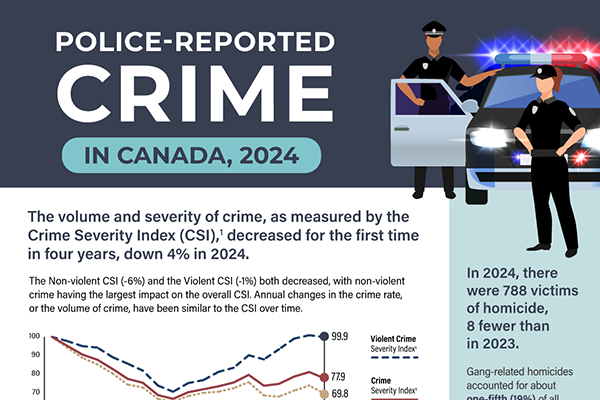
Infographic: Police-reported crime in Canada, 2024
Release date:
July 22, 2025
Data Visualization Tool:
Canada's Transgender and Non-Binary Population
Explore data with our Canada's Transgender and Non-Binary Population: Data Visualization Tool by age for province, territories and Census Metropolitan Areas (CMAs) based on data from the 2021 Census of Population.
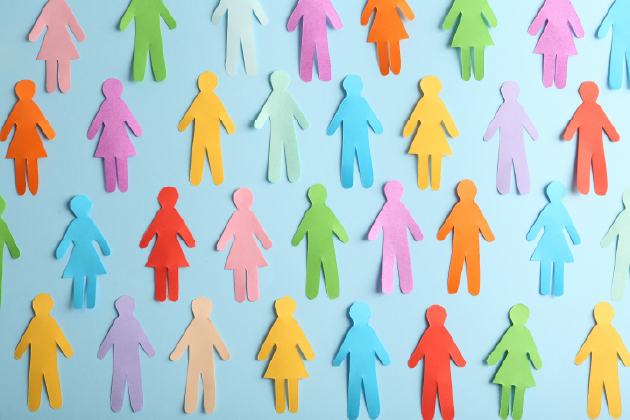
Additional information
Social inclusion statistics for Canada's ethnocultural groups
Welcome to the Social Inclusion portal linked to Canada's Anti-Racism Strategy and the Centre for Gender, Diversity and Inclusion Statistics. This portal brings together key statistical information on the inclusion (or exclusion) of ethnocultural groups and immigrants in Canada.
More information on social inclusion indicators for Canada's ethnocultural groups
Analytical products on social inclusion
- Data visualization tools — Social inclusion indicators for Canada's ethnocultural groups
- Reference guide on social inclusion indicators for Canada's ethnocultural groups
- The Daily - Social inclusion statistics for Canada's ethnocultural groups: New Products!
- The Daily - Housing conditions among racialized groups: A brief overview
- The Daily - Portrait of the social, political and economic participation of racialized groups
Disaggregated Data Action Plan
What is disaggregated data?
Disaggregated data are data broken down from large datasets into smaller segments such as gender, region, ethnicity or a combination of these to reveal underlying trends and differences between and within individual segments that may not be reflected in aggregated data.
Disaggregated data can better inform our understanding of the experiences of diverse people. The more a dataset is disaggregated, the more it is representative of the characteristics of the individuals that comprise the dataset. Without intersectional disaggregated data, data users risk inferring information about individuals and subpopulations based on inferences about the larger group. Thus, disaggregated data are needed to provide a more accurate and nuanced picture of the Canadian population.
Led by Statistics Canada, the Disaggregated Data Action Plan (DDAP) adopts a whole-of-government approach to provide all levels of government, businesses, policymakers, data users, non-profit organizations and the Canadian population with the detailed insights necessary for evidence-based decision-making for a more equitable Canada.
To the extent possible, data for each population group are broken down into subcategories according to gender, ethnocultural characteristics, age, sexual orientation and disability—or intersections of these and other subcategories, as needed. Data are also disaggregated to the lowest possible level of geography, as events affect people differently depending on where they live.
The Disaggregated Data Action Plan 2024-25 Accomplishment Report: From Commitment to Continuity presents the most recent progress made toward advancing representative data collection and strengthening statistics about Indigenous Peoples, women, racialized groups, persons with disabilities, and other population groups.
Previous DDAP Accomplishment Reports continue to be available through publications.gc.ca.
For more information on the Disaggregated Data Action Plan and related initiatives, please visit the Disaggregated Data Action Plan page.
Engaging Canadians on the visible minority concept
Engagement Initiative Objectives
The visible minority concept is currently under review. Statistics Canada is committed to engaging with partners, stakeholders, ethnocultural groups, and the general public to identify the appropriate terminology and categories to describe the population and properly address data needs in health, education, justice, and employment equity.
These consultative engagements on the Visible Minority Concept were conducted virtually with stakeholders and partners, ethnocultural groups, non profit and nongovernment organizations and researchers.
Results
Consult and comment initial findings of the engagement initiatives here: Visible minority concept consultative engagement
Gender-based Analysis Plus (GBA Plus)
Gender-based Analysis Plus (GBA Plus) is an analytical tool used to support the development of responsive and inclusive policies, programs, and other initiatives. GBA Plus is a process for understanding who is impacted by the issue or opportunity being addressed by the initiative; identifying how the initiative could be tailored to meet diverse needs of the people most impacted; and anticipating and mitigating any barriers to accessing or benefitting from the initiative. GBA Plus is an intersectional analysis that goes beyond biological (sex) and socio-cultural (gender) differences to consider other factors, such as age, disability, education, ethnicity, economic status, geography (including rurality), language, race, religion, and sexual orientation.
For additional information and resources on GBA Plus, check out the following links:
- Gender-based Analysis Plus (GBA Plus) - Women and Gender Equality Canada
- Gender-Based Violence Knowledge Centre - Women and Gender Equality Canada
- Health Inequalities Data Tool - Public Health Infobase
- Take the Gender-based Analysis Plus course - Women and Gender Equality Canada
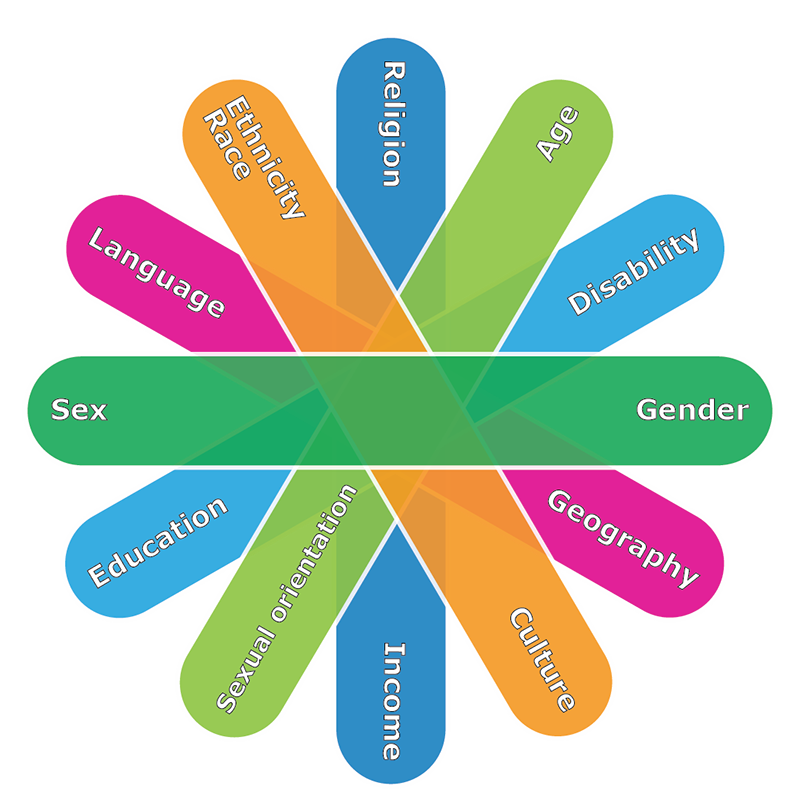
Description: Diversity Wheel
This figure illustrates some of the factors which can intersect with sex and gender. Six oblong shapes of differing colors overlap and fan out. Each oblong has two identity factors written on it. The top oblong has "sex and gender". Starting below sex and gender and going clockwise, the additional identities identified are: geography, culture, income, sexual orientation, education, language, race, ethnicity, religion, age and disability.
Framework and standards
Framework: The Sustainable Development Goals (SDGs) are a universal call to action to end poverty, protect the planet and improve the lives and prospects of everyone, everywhere. The Canadian Indicator Framework for the SDGs encompasses the 17 goals to support Canada's domestic implementation of the SDGs.
Standards: Statistical data and metadata standards are a set of rules about how data and metadata are managed, organized, represented, or formatted. They enable consistent and repeatable description, representation, structuring, and sharing of data and metadata.
Enhancing Data to Support Better Decision-Making for Canadians
The Government of Canada (GC) has announced the release of new gender and sex assigned at birth standards, which aim to improve the way data is collected, analyzed, and used across the country. These standards, which are aligned with Statistics Canada's own practices, are an essential part of efforts to modernize how the government approaches data on sex and gender.
What Are the New Standards and Why Do They Matter?
The Gender, sex at birth, sexual orientation, and related standards by variable are designed to ensure that data collected by the government is consistent, accurate, and reflective of the diversity within the Canadian population. By following these standards, the government can ensure that all datasets are comparable, making it easier to understand trends and differences across different regions and communities.
The standards will also support disaggregated data action plan - data that is broken down into smaller, more detailed categories, such as gender, ethnicity, and region. This enables a deeper understanding of the experiences of Canadians from various backgrounds. For example, the use of disaggregated data can uncover trends or challenges that may not be visible in broader, aggregated data, allowing for more targeted and effective policies and programs.
Collaborative Efforts
The development of these standards involved close collaboration between multiple government agencies, including Statistics Canada, the Office of the Chief Data Officer, and various other departments. These partnerships were crucial in ensuring the standards are both comprehensive and reflective of the needs of the Canadian public.
Where to find standards
You can explore all available GC Enterprise Data Reference Standards and policies while linking directly to the original standards on the data stewards' sites. This information can also be accessed on the Open Government Portal. Statistics Canada created Gender of Person and Sex at Birth of Person reference guides. Each guide provides information on the standard, including useful links to the variable, classification(s) and reference documentation, as well as details on the questions used. Access Statistics Canada's complete repository of standard classifications, variables and statistical units by visiting Standards, data sources and methods. This page brings together information that will assist in the interpretation of Statistics Canada's published data.
International initiatives
Sustainable Development Goals and Gender Equality
Goal 5 - Gender equality of the United Nations Sustainable Development Goals is to achieve gender equality and empower all women and girls.
Gender in the international context
Related hubs and portals
Visit other hubs and portals
Consult our subject specific hubs and portals for all the related data, analysis and reference resources. These pages contain information on topics important to the GDIS.
Sign up to My StatCan to get updates in real-time.
- Date modified:
